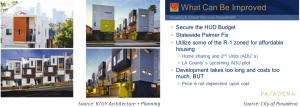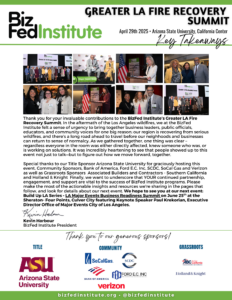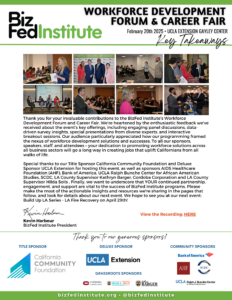
House Now: Turning NIMBY to YIMBY
Woodbury University – Friday, November 18, 2016
Thank you to our generous sponsors: City National Bank, Southland Regional Association of Realtors, Inc., Union Bank, Woodbury University, California Community Foundation, Southern California Association of Governments, California Economic Summit, and Randy Witt Productions
You can experience the BizFed Institute’s NextUp Economic Forum: Housing Now: Turning NIMBY to YIMBYÂ in its entirely online via YouTube. Please click any of the following links for the segment you wish to view or view full playlist here:
- Introduction
- Panel 1:Â The Cost of Not Building One Million More Homes
- Panel 1: Q & A
- Panel 2:Â NIMBY to YIMBY: Digging for Answers to Get Shovels in the Ground
- Panel 2: Q & A
To view full slideshow, click here.
To view Speakers’ full bios, click here.
Panel 1:Â The Cost of Not Building One Million More Homes
Speakers:
Theresa Don Lucas, City National Bank
Steve Pontell, National Community Renaissance
Darin Chidsley, Southern California of Governments
Webster Guillory (Ret.), County of Orange
Linda Wheaton, California Department of Housing & Community Development
Highlights:
Housing is a business and won’t get fixed simply because it makes
social sense.
Shelter is a basic need, so focus on the people affected by the crisis.
Everyone agreed that we have a housing crisis.
We’re exceeding capacity of infrastructure design and services due to overcrowding from the housing shortage.
Ballot box legislation will most likely lead to less precise and less constructive decisions.
Housing affordability will be one of the key priorities of the legislative session in 2017, so the momentum to act is now.
LA county is highest ranked county in disinvestment occurrences.
Subsidies are still a taxation and its consequences can create distortion
in the marketplace.
Educate policymakers and citizens about the needs and role of existing housing laws and tools available.
Identify the potential for increased development in underutilized development capacity within existing areas.
Figure out better way(s) to align housing supply where it’s in demand or adjust demand to where supply is located.
Address the interplay/nexus between civic engagement and generational changes.
Panel 2:Â NIMBY to YIMBY: Digging for Answers to Get Shovels in the Ground
Speakers:
Mike Lewis, Lewis Associates
Mel Wilson, Southland Regional Association of Realtors
Sandy Brown, Westwood Neighborhood Council
Stephanie Caldwell, Los Angeles County Department of Public Health
Manny Gonzalez, KTGY
William Huang, City of Pasadena
Mark Vallianatos, Abundant Housing LA
Highlights:
Timing is key and use the right terminology to manage buy-in and potential conflict within neighborhoods.
More housing of all types with an “all-of-the-above†approach, including density, greenfield, second units, etc.
Housing advocates need to be more active in early outreach, especially to neighborhood councils in person.
NIMBYs understand the necessity of affordable housing, but when local issues are more immediate, they need education on the urgency.
Neighborhood councils agree that general and housing element plans need to be updated.
Unaffordable, unstable, and low quality housing contribute to public safety and health issues.
Utilize small lot ordinances and R-1 zoning.
Even if fees and costs go down, purchase and rental prices are driven by the market.
Enforce rights for people who own and rent.
Innovate building materials, types of productions, living arrangements, etc.
Certain fees makes sense where the market can absorb it and where there is a lot demand.
CEQA statewide and moratoriums, like the Neighborhood Integrity Initiative locally, are big roadblocks.
Timing is key and use the right terminology to manage buy-in and potential conflict within neighborhoods.





